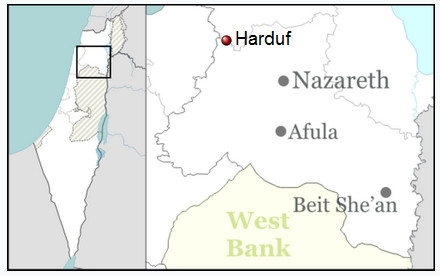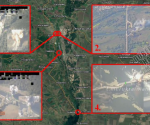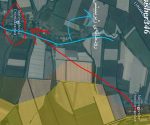Israel’s F-16 disaster, Hezbollah’s new strategic era; did Syria shut down Lebanese airspace?
There is an important detail about Saturday’s downing of the Israeli F-16 war plane that gets left out in all the excitement, or on purpose – depending on whom one is reading. This feature of the story is not an insignificant one either, and so it is a surprise that it can’t be found anywhere on the internet. The point of fact that is so hard to establish is where, exactly, was the plane when it was targeted by Syrian air defences. All the evidence points to it having been in Lebanese airspace, and this would be important because of the way Israel has developed a method of launching attacks in to Syria with standoff missiles fired from aircraft that go no further than the Lebanese border. This way, presumably, the Israeli Air Force would avoid running the risk of morale-sapping losses to men and materiale and the weakness that that would telegraph to the enemy. It would surely be quite the coup for Syria if it had made Lebanese airspace too difficult to cross at its own leisurely discretion.
In a statement made after the F-16 was shot down, Hezbollah indicated that it certainly perceived the alteration in the balance of power:
This is the beginning of a new strategic era which puts an end to the violation of Syrian airspace and territory… Today’s developments mean the old equations have categorically ended.
It couldn’t be more clearer than that: Hezbollah thinks that Israel’s ability to violate Syrian airspace and territory has been put to an end.
We’ll return to this idea to reinforce it shortly – and to examine exactly how it might have been done – but before that a few facts need to be established. First of all, examine the history of Israeli attacks into Syria from Lebanon as illustrated in the following extracts from various dates since 2013:
“This morning Israeli warplanes fired several missiles from Lebanese airspace on one of our military positions in the Damascus countryside,” it [the Syrian military] said. “Our air defence systems blocked them and destroyed most of them.”
7th February 2018 (source).
Israel fired missiles at a military base Iran has been building near the Syrian city of al-Qiswa, southwest of Damascus, reportedly destroying an arms depot, according to numerous Arab media reports overnight Friday-Saturday…
A Sky News Arabic report said that the missiles were fired from within Lebanese airspace.
2nd December 2017 (source).
Israeli jets have attacked a Syrian government anti-aircraft missile launcher after it fired on its aircraft patrolling in Lebanese air space on a photographic reconnaissance mission, the Israeli military said.
16th October 2017 (source).
Last Wednesday, the Syrian authorities said Israeli jets had fired two air-to-surface missiles from Lebanese airspace towards Sabboura, a north-western suburb of Damascus that is located on the main road from the city to the Lebanese border.
7th December 2016 (source).
Israeli warplanes attacked a target on the Lebanese-Syrian border overnight Tuesday, foreign media reported on Wednesday. While some reports said the purported strike was carried out on the Syrian side of the border, according to one source the target was a weapons convoy that had crossed from Syria into Lebanon…
Lebanese officials said a dozen Israeli warplanes violated Lebanese airspace on Tuesday and overnight into Wednesday, flying close to the ground in several sorties over southern Lebanon.
30 January 2013 (source).
The author doesn’t know if Israeli jets have ever ventured into Syria during the course of the conflict, but the evidence is certainly there to confirm that they have attacked from Lebanon. One might suppose [and it is a stab in the dark] that this tactic is to do with not wanting to make ground sites on Israel a legitimate target for Syrian reprisal; the Israelis have been known to counter surface-to-air missiles with intercepts by anti-missile weaponry to prevent contact with targeted aircraft. With Israeli aircraft operating out of Lebanon, Israel only has to fire missiles from the ground into Lebanon. That being said, one can’t help but feel that there might be a technical more than a legal explanation [if the reader has one, please get in touch].
In any case, from certain reports, it appears as though the Israeli planes that were targeted by Syrian forces on Saturday were, as per the tactic suggested by the above evidence as being preferred, operating from Lebanon. “Syrian Air Defense launched ~ 8 missiles towards Lebanese air space” reported the Syria.liveuamap website. “Syrian, Israeli missile debris land in Lebanon”, reported the Lebanese Daily Star, with accompanying images.
The following, from the Jerusalem Post, was more extensive:
It should be noted that one of the SA-5 (S-200) missiles fired at the Israeli planes landed in an agricultural area in Wadi Hatzbani in southern Lebanon. According to assessments made by the Lebanese security forces, the missile was aimed at one of the Israeli planes that attacked Syria.
One would expect that a decisive piece of evidence would be the location of the crash site, although it is not known how long the aircraft was able to stay airborne before the pilots had to eject from it (in other words, we shouldn’t expect the crash site to be directly underneath the location of the lethal missile hit – and a plane will travel forward even if it is falling). SANA, the Syrian state broadcaster, reported that this was in Galilee; other reporting narrowed this down to the Jezreel Valley, and more specifically, the Harduf kibbutz. Please consult the map. Would this aircraft have been more likely to have been coming from Lebanon or Syria after having delivered its payload?
Returning, now, to the main issue at hand; the basic proposal that Syrian airspace and territory has been put off limits to Israel. We left off with Hezbollah’s confident assessment of the fact of a strategic transformation– one that also seems to be shared in Western quarters; this is from the New York Times:
The jet crash represented a severe blow to Israel’s prestige and could mark a major change after years in which Israel has acted against targets in Syria with relative impunity.
We should also mark the behaviour of the Israelis. After the downing of the F-16 they conducted retaliatory airstrikes against what they called Iranian assets in Syria, and Syrian military targets – what the BBC described as the most significant against Syria since the 1982 Lebanon war. After this they then let it be known that they had gone to the Russians to ask that the Syrians and the Iranians do not themselves strike back:
Israel appealed to Russia to intervene and prevent further escalation after an Iranian drone was shot down over Israel Saturday, leading to “large-scale” Israeli strikes in Syria and heavy Syrian counter-fire.
Diplomatic sources said Israel was in contact with officials in Moscow, seeking to convey a message to Syria and Iran that though it had landed a heavy blow in response to the drone incident, it was not interested in further violence.
There is no other way to construe this but as a climb-down: the sort of “please don’t hit me” begging after the knockout punch wasn’t forthcoming as expected after all. For it appears that this most significant set of airstrikes that was supposed to represent the Israelis climbing back on to the horse after a fall was nothing of the sort, and failed miserably to boot, according to Lebanese sources (as reported in an Israeli outlet):
The Lebanese television station Al Mayadeen reported that Syrian air defense systems attacked the Israeli F-16 jet. A correspondent for the station – affiliated with the Syrian regime – reported that “the Israeli fighter planes did not dare enter Syrian airspace after the plane was downed, and the missiles, which Israel used to attack the Syrian air defense system, were launched from the heart of the Mediterranean Sea.”
The station also claimed that more than 70% of the missiles launched by Israel into Syria recently were shot down by Syria’s air defense system… A senior military source in Syria told the Russian news agency Sputnik that the Syrian defense system had shot down six Israeli missiles launched at Syrian military posts.
In another clue, in the immediate aftermath of the F-16 downing, the Lebanese Government fixed to make a complaint to the UN about Israel’s abuse of Lebanese airspace. Apparently, this is not the first time that the UN has thus been petitioned, but the timing on this occasion is interesting. Could it be about offering Israel a face-saving way of bowing out of interference in the Syrian conflict?
While the reader might not be confident about Israel’s compliance with any norms of international relations, whether they be expressed in a UN motion or not, we can all be certain that Israel has been involved in face-saving activity ever since one of its jets was shot down and another, an F-15 (according to some sources), was also damaged. The lead set by the Israeli military in initially refusing to acknowledge the direct correlation between crashed airplane and Syrian air defences was followed slavishly by all Western corporate-media. The prize for most stunning denialist headline of the moment definitely went to the one that appeared at the New York Times: “Israel Attacks Targets in Syria After Iranian Drone Enters Israeli Airspace and Jet Crashes”. This headline belonged to the article that is linked to above, although the reader cannot inspect it because it has been changed in the last 24 hours to read “Israel Strikes Iran in Syria and Loses a Jet”. Although less like obvious state-controlled propaganda, the new version still pushes an important talking point that the Anglo-globalist cabal (by which the author means the British Israeli/American Christian Identity/Sionist Masonic ruling elite) evidently wants instilled in the public consciousness as doublethink: it wasn’t the Syrians that gave Israel a bloody nose, it was the Iranians. It is, of course, obvious codswallop. But the myth that the Assad Syrian Government is in its last hours of life and racked with the death-spasms of terror that keep flaring up and can’t be stamped out must be sustained; the USA and Israel must have an excuse to intervene. Additionally, the idea of a Syria that could beat Israel in a war (the author thinks that the Syrian Arab Army must, by now, be amongst the best soldiery in the world [note to British special forces: shooting unarmed electricians on the London Underground doesn’t qualify]) is something that must be kept from the minds of a Western public otherwise convinced of Israel’s invincibility. The perception of Israel as a certainty is a factor in its continued existence. People in the West can’t stand a “loser” – of course, people in the West at the moment are the dumbest that ever walked the surface of the Earth, but they aren’t so stupid that they won’t keep paying taxes to throw good money after bad. Then there is the local impact in Israel. If Syria showed that it can close down Lebanese airspace, what chance has Israel in any new war on Hezbollah? A new strategic era, indeed.



















